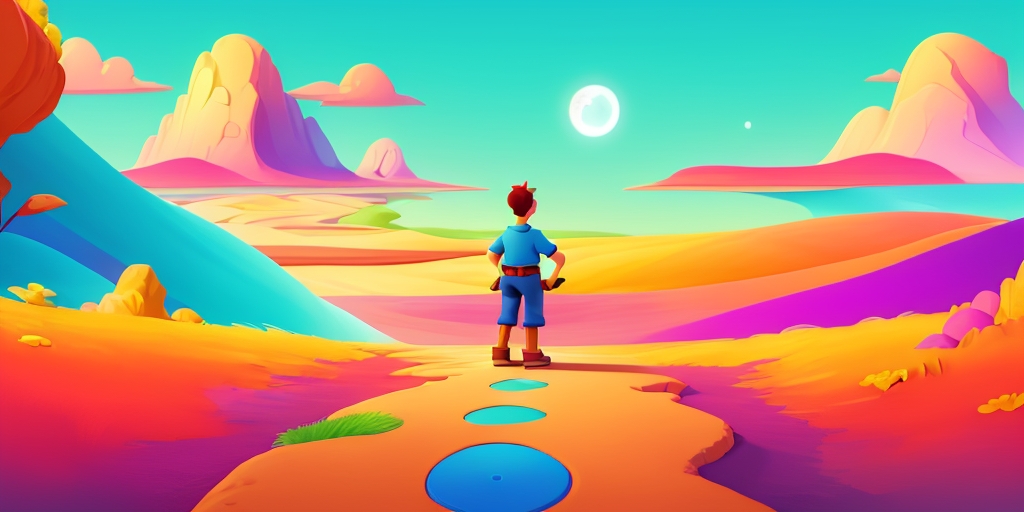What is Content Creation for Websites? Unraveling the Mystery
I am a creative and analytical person who enjoys problem-solving and finding creative solutions. I am driven by curiosity and a passion for learning, and take initiative to explore and understand new concepts. I am a great communicator and collaborate well with others, and am always looking for opportunities to improve myself and my team.
What is Content Creation for Websites? Unraveling the Mystery
Understanding the Challenge of Content Creation
Content creation for websites is not as simple as it sounds. It's a complex process that involves understanding your audience, identifying relevant topics, creating engaging content, and optimizing it for search engines. Some common challenges include:
- Identifying relevant and engaging topics
- Creating content that resonates with your audience
- Optimizing content for search engines
- Maintaining consistency in content creation
Moreover, there are several misconceptions about content creation. Some believe it's all about writing lengthy articles, while others think stuffing keywords will do the trick. The truth is, effective content creation is a strategic process that requires a deep understanding of your audience, your brand, and the digital landscape.
The Solution: A Strategic Approach to Content Creation
So, how can you overcome these challenges and create effective content for your website? The answer lies in adopting a strategic, step-by-step approach to content creation. This involves:
- Understanding your audience and their needs
- Identifying your unique value proposition
- Creating engaging and relevant content
- Optimizing your content for search engines
- Consistently updating and refreshing your content
By following this approach, you can create content that not only attracts visitors but also keeps them engaged and encourages them to take action.
Why Content Matters
Now, you might be wondering, why does content matter so much? Well, content is the backbone of your website. It's what attracts visitors, keeps them engaged, and encourages them to take action. According to a study by HubSpot, companies that blog regularly generate 55% more website visitors, 97% more inbound links, and 434% more indexed pages than those that don't.
Moreover, content plays a crucial role in search engine optimization (SEO). Search engines like Google reward websites that provide high-quality, relevant, and updated content. So, by creating effective content, you can improve your website's visibility, attract more visitors, and increase your chances of conversion.
But how do you create content that aligns with different stages of the client lifecycle? And how can you ensure your content communicates what makes your website unique? Stay tuned as we delve into the process of content creation in the next section.

The Process of Content Creation
Creating content for your website is not a random act. It's a process that requires careful planning and execution. But what does this process look like? Let's break it down.
Identifying Your Unique Value Proposition
Before you start creating content, you need to understand what makes your website unique. This is your unique value proposition (UVP). Your UVP is what sets you apart from your competitors. It's the reason why visitors should choose your website over others.
For example, if you run a fitness blog, your UVP could be your unique approach to fitness, your personal fitness journey, or your expertise in a specific area of fitness. Once you've identified your UVP, you can use it to guide your content creation process.
Remember, as Oscar Wilde once said, "Be yourself; everyone else is already taken." Your UVP is what makes you unique, so don't be afraid to let it shine through your content.
Mapping Content to the Client Lifecycle
Once you've identified your UVP, the next step is to create content that aligns with different stages of the client lifecycle. The client lifecycle refers to the different stages a client goes through, from the moment they first discover your website to the moment they become a loyal customer.
Here's a simple way to map your content to the client lifecycle:
- Awareness: At this stage, the client has just discovered your website. Your content should aim to educate them about your UVP and how it can solve their problems.
- Consideration: Now, the client is considering whether to use your website or not. Your content should provide more detailed information about your UVP and demonstrate its value.
- Decision: The client is ready to make a decision. Your content should convince them that choosing your website is the best decision they can make.
- Retention: The client has chosen your website. Your content should aim to keep them engaged and encourage them to become a loyal customer.
By mapping your content to the client lifecycle, you can ensure that your content is always relevant and valuable to your audience.
Now that we've covered the process of content creation, are you ready to dive into some examples? In the next section, we'll explore different types of content and how they can be used effectively. Stay tuned!

Examples of Content Creation
Content creation is not a one-size-fits-all process. It's a vibrant, dynamic field that encompasses a wide range of formats and styles. Let's dive into some examples of different types of content and how they can be used effectively.
The Art and Science of Web Content Creation
Creating content for the web is both an art and a science. It requires a delicate balance between creativity and strategy. On one hand, you need to create content that is engaging, compelling, and unique. On the other hand, you need to ensure that your content is optimized for search engines and aligns with your overall marketing strategy.
Take, for example, a blog post. It's not just about stringing together a bunch of words. It's about telling a story, engaging your audience, and providing value. At the same time, it's about using the right keywords, structuring your content properly, and ensuring that it's easily shareable on social media.
As Steve Jobs once said, "Design is not just what it looks like and feels like. Design is how it works." The same principle applies to content creation. It's not just about what your content says, but how it works to achieve your goals.
Diverse Forms of Content
Content comes in many shapes and sizes. Here are a few examples:
- Blog posts: These are a staple of any content strategy. They're great for sharing insights, providing value, and establishing your brand as an authority in your field.
- Videos: Videos are incredibly engaging and can convey a lot of information in a short amount of time. They're perfect for tutorials, product demos, and storytelling.
- Podcasts: Podcasts are a great way to share in-depth discussions and interviews. They're also a great way to connect with your audience on a more personal level.
- Infographics: Infographics are a visually appealing way to present complex information or data. They're highly shareable and can help boost your brand's visibility.
- Ebooks: Ebooks are a great way to provide in-depth information on a specific topic. They're also a great lead generation tool.
Each of these content types serves a different purpose and can be used to reach different segments of your audience. The key is to understand your audience and create content that resonates with them.
But how do you ensure that your content is not only engaging but also effective in achieving your goals? That's where the five key elements of content creation come into play. Curious to know what they are? Stay tuned for the next section where we'll delve into these crucial elements.
The 5 Key Elements in Creating Your Website Content
Creating content for your website is not just about writing a bunch of words and hoping for the best. It's about crafting a message that resonates with your audience and drives them to take action. To do this effectively, there are five key elements you need to consider.
Knowing Your Audience
Understanding your audience is the first step in creating compelling content. You need to know who they are, what they want, and what problems they are trying to solve. This will allow you to create content that speaks directly to their needs and goals.
For example, if you're a fitness coach targeting busy professionals, your content should focus on quick and efficient workouts, healthy meal prep tips, and ways to stay motivated despite a hectic schedule. This kind of targeted content will be much more effective than generic fitness advice.
.jpg)
SEO Optimization
Once you know your audience, the next step is to make sure they can find your content. This is where SEO, or Search Engine Optimization, comes in. SEO is all about making your content visible to search engines, so it can be found by your target audience.
There are many aspects to SEO, but some of the most important include:
- Using relevant keywords in your content
- Creating high-quality, original content
- Optimizing your website's speed and mobile-friendliness
- Building backlinks to your content from other reputable websites
By focusing on these elements, you can increase your content's visibility and reach a larger audience. As the famous saying goes, "Content is king, but distribution is queen and she wears the pants."
But how do you balance the need for SEO with the need to create content that resonates with your audience? And how do you ensure that your content is not only found, but also read and shared? Stay tuned, as we'll be diving into these questions in the next section.
Overcoming Challenges in Content Creation
Creating content for your website can be a daunting task. It's not just about writing a few words and hoping for the best. It requires a strategic approach, a deep understanding of your audience, and a commitment to consistency. But, like any other task, it comes with its own set of challenges. Let's delve into some of these challenges and discuss how you can overcome them.
Staying Consistent
One of the biggest challenges in content creation is maintaining consistency. It's easy to start with a bang, but as time goes on, it can become increasingly difficult to keep up the pace. You might find yourself struggling to come up with new ideas or losing motivation.
So, how do you stay consistent? Here are a few tips:
- Plan Ahead: Having a content schedule can be a lifesaver. It helps you plan your content in advance, ensuring you always have something to work on.
- Batch Your Work: Instead of creating content piece by piece, try batching. This means creating multiple pieces of content in one sitting. It's a great way to stay ahead of schedule.
- Stay Inspired: Keep a list of content ideas. Whenever inspiration strikes, jot it down. This way, you'll always have a pool of ideas to draw from.
A study by CoSchedule found that marketers who proactively plan their projects are 356% more likely to report success. So, planning and staying consistent can indeed make a significant difference in your content creation journey.

Conclusion: Embracing the Art of Content Creation
Content creation is an art. It's about telling a story, engaging your audience, and providing value. It's not always easy, but with the right approach, it can be a rewarding and fulfilling process.
Remember, every challenge is an opportunity for growth. So, don't be disheartened by the hurdles you face in your content creation journey. Instead, embrace them, learn from them, and keep moving forward.
As the famous writer, Stephen King once said, "Amateurs sit and wait for inspiration, the rest of us just get up and go to work." So, get up, start creating, and embrace the art of content creation. Your audience is waiting to hear your unique voice.



.jpg)
.jpg_nowm_640.jpg)

.jpg)
.jpg_nowm_1260.jpg)